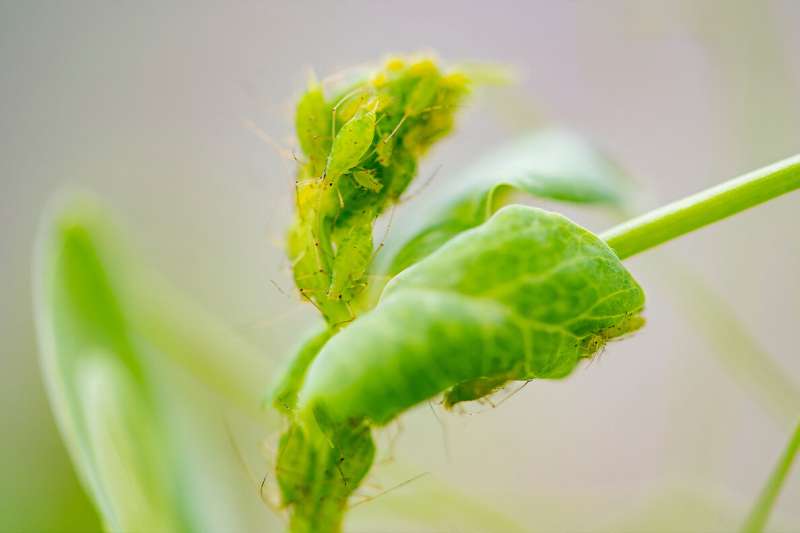Pest attack-order changes plant defenses

The dining time of different insects impacts a plant's defenses and nutritional quality—a complexity uncovered in new research with implications for pest management strategies.
A piercing-sucking, virus-carrying aphid has long worried pea plant farmers, but a more innocuous-seeming weevil that only takes tiny bites from leaves was found to also play a significant role in plant health. Depending if the weevils eat before, or after, the aphids, they can increase or decrease the plant's ability to fend off the virus.
While many studies have focused on the impacts of a single pest, this study, published Aug. 4 online in Molecular Ecology, is one of the few to look at the interaction of several antagonists, in this case, two pests and a virus.
"Plants in the field have a chance of being exposed to many different types of biotic stress elements, what we call antagonists," said Saumik Basu, a WSU post-doctoral fellow and the study's lead author. "Based on how these antagonists are coming to the plants, that can change the plant responses and ultimately leads to changes in their overall productivity."
Through a set of greenhouse experiments, Basu and colleagues from the Crowder Laboratory at WSU and Cornell University attempted to understand what happens to the pea plant fields of Eastern Washington's Palouse area. In the field, plants face alternating infestations of pea leaf weevils, Sitona lineatus, and pea aphids, Acrythosiphon pisum, and a pathogen the pea aphids are also known to carry, Pea enation mosaic virus, or PEMV.
The researchers created experiments where first the weevils feasted on the plants then the aphids, and others that reversed the order. They also included scenarios where the plants were infected with the virus and some where they did not as well as a control group.
After removing the pests, the researchers let the plants grow for a week. Then, they ran plant samples through different sets of analyses to assess the plants' defense hormone levels and associated defense genes as well as nutritional qualities.
They found that when the weevil feasts first on the pea plants, it enhances some of the plants' anti-pathogen defense responses, helping them become more resilient to a virus infection.
If the weevil dines second, after the aphids, it usually reduces the anti-pathogen defense responses, so the virus spreads more easily.
In turn, virus-infected plants had stronger anti-herbivore responses, putting out compounds that interfere with the plant-eating pests.
Further complicating the issue, the study found that when the weevils helped induce the anti-pathogen responses it lowered the nutrition of the plant by reducing the plants' available amino acids.
These complex interactions hold important implications for pest management, Basu said.
"If we know beforehand when these interactions are happening, that information gives farmers a best possible remedy to prevent their fields from the attack," he said. "This kind of information is really important for designing sustainable pest and pathogen management strategies."
This study is part of a series of investigations into the interactions among many organisms that plants encounter. An earlier study in Functional Ecology looked at the antagonism between a plant virus and nitrogen-fixing bacteria called rhizobia that live in the soil. An upcoming study looks at the interaction between the weevils and rhizobia.
These complex relationships are critical to understanding plant responses, said Basu.
"In a natural environment, a plant is exposed to different types of organisms, not just one or two, but many," he said. "The order and the complexity—how many there are, what different types there are and their interactions—affect how the plant responds to all these attackers."
More information: Saumik Basu et al, Responses of pea plants to multiple antagonists are mediated by order of attack and phytohormone crosstalk, Molecular Ecology (2021). DOI: 10.1111/mec.16103
Saumik Basu et al, Reciprocal plant‐mediated antagonism between a legume plant virus and soil rhizobia, Functional Ecology (2021). DOI: 10.1111/1365-2435.13828
Journal information: Functional Ecology , Molecular Ecology
Provided by Washington State University


















